Metabo SBE 521, SBE 550, SBE 561, SB 561, BE 561 User guide [ml]
...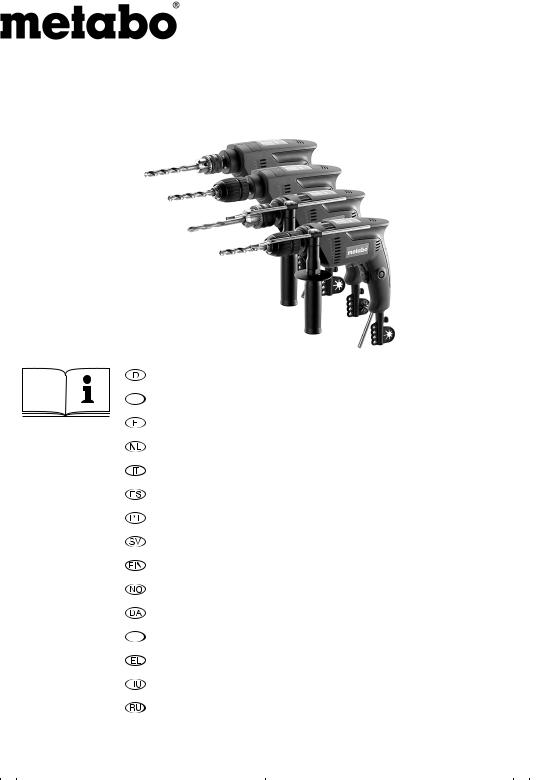
SBE 521 SBE 550 SBE 561 SB 561 BE 561 B 561
ENG
POL
Gebrauchsanleitung .............. |
Seite |
5 |
Operating Instructions........... |
page |
10 |
Mode d’emploi ...................... |
page |
15 |
Gebruiksaanwijzing ......... |
bladzijde |
20 |
Istruzioni d’uso ................... |
pagina |
25 |
Instrucciones de manejo .... |
página |
30 |
Instruções de serviço ......... |
página |
35 |
Bruksanvisning ....................... |
sida |
40 |
Käyttöohje ............................... |
sivu |
45 |
Bruksanvisning ....................... |
side |
50 |
Betjeningsvejledning .............. |
side |
55 |
Instrukcja obsługi ................ |
strona |
60 |
δηγίες ρήσης................ |
Σελίδα |
65 |
Használati útmutató .............. |
oldal |
71 |
Инструкция по использованию.. стр. |
76 |
|
170 26 8610 - 0108
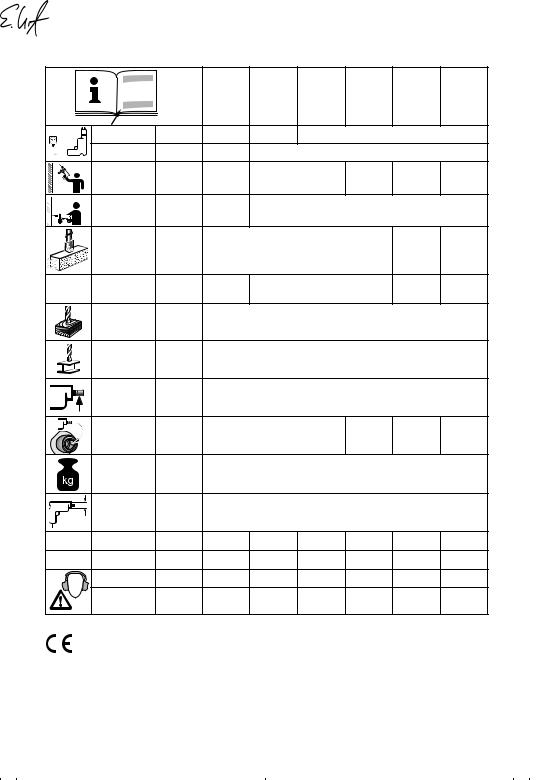
13 |
|
<![if ! IE]> <![endif]>SBE521 |
<![if ! IE]> <![endif]>SBE550 |
<![if ! IE]> <![endif]>SBE561 |
<![if ! IE]> <![endif]>561SB |
<![if ! IE]> <![endif]>561BE |
<![if ! IE]> <![endif]>561B |
P1 |
|
||||||
W |
520 |
550 |
|
560 |
|
||
P2 |
W |
300 |
|
|
320 |
|
|
n0 |
/min |
0-2600 |
0-2800 |
2800 |
0-2800 |
2800 |
|
n1 |
/min |
1600 |
|
|
1700 |
|
|
ø max. |
mm |
|
12 (1/2“) |
|
- |
- |
|
(in) |
|
|
|||||
|
|
|
|
|
|
|
|
s max. |
/min. |
47000 |
|
50000 |
|
- |
- |
bpm |
|
|
|||||
|
|
|
|
|
|
|
|
ø max. |
mm (in) |
|
|
20 (3/4“) |
|
|
|
ø max. |
mm (in) |
|
|
10 (3/8“) |
|
|
|
G |
UNF (in) |
|
|
1/2“-20 |
|
|
|
|
|
|
|
|
|
||
H |
mm (in) |
|
6,35 |
|
- |
6,35 |
- |
|
(1/4“) |
|
(1/4“) |
||||
|
|
|
|
|
|
||
m |
kg (lbs) |
|
|
1,7 (3.7) |
|
|
|
D |
mm |
|
|
43 |
|
|
|
(in) |
|
|
(1 11/16“) |
|
|
||
|
|
|
|
|
|||
ah, ID/Kh, ID |
m/s2 |
28 / 2,0 |
28 / 2,0 |
28 / 2,0 |
28 / 2,0 |
- |
- |
ah, D/Kh, D |
m/s2 |
5 / 1,5 |
5 / 1,5 |
5 / 1,5 |
5 / 1,5 |
5 / 1,5 |
5 / 1,5 |
LpA/KpA |
dB(A) |
96 / 3 |
96 / 3 |
96 / 3 |
96 / 3 |
81 / 3 |
81 / 3 |
LWA/KWA |
dB(A) |
107 / 3 |
107 / 3 |
107 / 3 |
107 / 3 |
92 / 3 |
92 / 3 |
EN 60745 |
|
|
|
|
|
|
|
98/37/EG ( 28.12.09), 2006/42/EG (29.12.09 ), 2004/108/EG |
|
|
|||||
Erhard Krauß, Geschäftsführung
© 2008 Metabowerke GmbH, 72622 Nürtingen, Germany
2
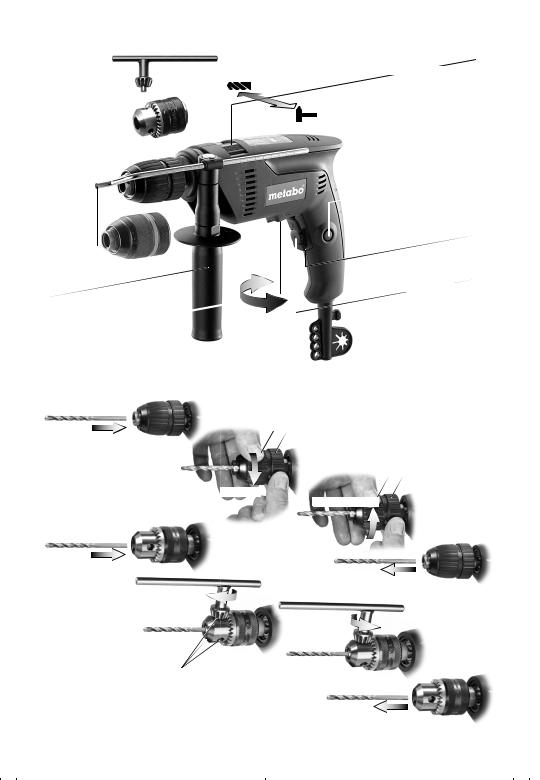
1
2
3
4
SBE 561, SBE 550, SBE 521, SB 561
5
SBE 561, SBE 550, SBE 521, SB 561
6
SBE 561, SBE 550, SBE 521, BE 561
7
SBE 561, SBE 550, SBE 521, SB 561
8
9
10
SBE 561, SBE 550, SBE 521, BE 561
b a
b a
GRIP, ZU
AUF, RELEASE
3 x
3
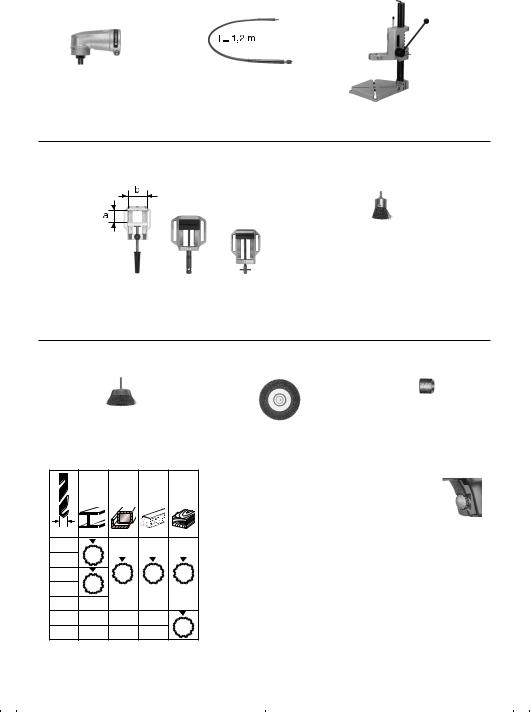
A B C
6.31078 |
6.27608 |
6.00890
D E
6.30554
a=80 |
a=100 |
a=86 |
b=80 |
b=100 |
b=80 |
6.27106 |
6.12001 |
6.12003 |
F
6.30552
6.30553
SBE 561, SBE 550, SBE 521
|
ALU |
|
|
|
ø |
|
|
|
|
mm |
|
|
|
|
4 |
6 |
|
|
|
6 |
|
|
||
6 |
6 |
6 |
||
8 |
||||
5 |
|
|
||
10 |
|
|
||
|
|
|
||
12 |
|
|
|
|
16 |
|
|
5 |
|
20 |
|
|
||
|
|
|
|
G |
|
|
|
|
H |
SBE 561 |
|
|
|
|
|
|
|
|
|
|
||
|
|
|
|
|
|
|
SBE 550 |
|
|
|
|
6.30551 |
|
|
|
SBE 521 |
|
||
|
|
|
|
|
BE 561 |
|
|||
|
|
6.30550 |
|
|
|
6.31281 |
|
||
|
|
|
|
|
|
|
|
||
|
|
|
|
|
|
|
|
|
|
|
|
1 |
2 |
3 |
4 |
5 |
6 |
|
|
|
|
|
|
||||||
|
|
|
|
|
|
|
|
|
|
|
SBE 521 |
1100 1400 |
1700 |
2000 2300 2600 |
.../min |
|
|||
|
|
|
|
|
|
|
|
|
|
|
SBE 550, |
|
|
|
|
|
|
|
|
|
SBE 561, |
1300 1600 |
1900 |
2200 2500 2800 |
.../min |
|
|||
|
BE 561 |
|
|
|
|
|
|
|
|
|
|
|
|
|
|
|
|
|
|
|
|
50 |
40 |
30 |
20 |
15 |
10 |
% |
|
|
|
|
|
|
|
|
|
|
|
4

DEUTSCH D
Gebrauchsanleitung
Sehr geehrter Kunde,
vielen Dank für das Vertrauen, das Sie uns beim Kauf Ihres neuen Metabo Elektrowerkzeugs entgegengebracht haben. Jedes Metabo Elektrowerkzeug wird sorgfältig getestet und unterliegt den strengen Qualitätskontrollen der Metabo Qualitätssicherung. Die Lebensdauer eines Elektrowerkzeugs hängt aber in starkem Maße von Ihnen ab. Beachten Sie bitte die Informationen dieser Gebrauchsanleitung und der beiliegenden Dokumente. Je sorgsamer Sie Ihr Metabo Elektrowerkzeug behandeln, umso länger wird es zuverlässig seinen Dienst erfüllen.
Inhalt |
|
|
2 |
Bestimmungsgemäße |
||
|
|
|
|
|
|
Verwendung |
1 |
Konformitätserklärung |
|
|
|||
|
|
|
||||
|
|
|
||||
2 |
Bestimmungsgemäße Verwendung |
|
SBE 561, SBE 550, SBE 521, SB 561: |
|||
3 |
Allgemeine Sicherheitshinweise |
|
Die Maschine ist geeignet zum Bohren ohne |
|||
4 |
Spezielle Sicherheitshinweise |
|
Schlag in Metall, Holz, Kunststoff und ähnlichen |
|||
|
Materialien und zum Schlagbohren in Beton, Stein |
|||||
5 |
Überblick |
|
||||
|
und ähnlichen Materialien. |
|||||
6 |
Inbetriebnahme |
|
||||
|
BE 561, B 561: |
|||||
|
6.1 |
Montage des Zusatzhandgriffs |
|
|||
|
|
Die Maschine ist geeignet zum Bohren ohne |
||||
|
|
(SBE 561, SBE 550, SBE 521, SB 561) |
|
|||
|
|
|
Schlag in Metall, Holz, Kunststoff und ähnlichen |
|||
7 |
Benutzung |
|
Materialien. |
|||
|
7.1 |
Verstellen des Bohrtiefenanschlags |
|
SBE 561, SBE 550, SBE 521, BE 561: |
||
|
|
(SBE 561, SBE 550, SBE 521, SB 561) |
|
Die Maschine ist zum Gewindeschneiden und zum |
||
|
7.2 |
Ein-/Ausschalten |
|
Schrauben geeignet. |
||
|
|
Für Schäden durch nicht bestimmungsgemäßen |
||||
|
7.3 |
Drehzahl vorwählen |
|
|||
|
|
(SBE 561, SBE 550, SBE 521, BE 561) |
|
Gebrauch haftet allein der Benutzer. |
||
|
|
|
Allgemein anerkannte Unfallverhütungs- |
|||
|
7.4 |
Umschalten Bohren/Schlagbohren |
|
|||
|
|
(SBE 561, SBE 550, SBE 521, SB 561) |
|
vorschriften und beigelegte Sicherheitshinweise |
||
|
|
|
müssen beachtet werden. |
|||
|
7.5 |
Drehrichtung wählen |
|
|||
|
|
|
|
|||
|
|
(SBE 561, SBE 550, SBE 521, BE 561) |
|
|
|
|
|
|
|
3 |
Allgemeine |
||
|
7.6 |
Werkzeugwechsel |
|
|||
|
|
Schnellspann-Bohrfutter Futuro Plus |
|
|
Sicherheitshinweise |
|
|
7.7 |
Werkzeugwechsel |
|
|
|
|
|
|
|
|
|||
|
|
Zahnkranz-Bohrfutter |
|
|
WARNUNG – Zur Verringerung eines |
|
|
7.8 |
Bohrfutter abnehmen |
|
|
Verletzungsrisikos Betriebsanleitung |
|
8 |
Tipps und Tricks |
|
|
lesen. |
||
|
|
WARNUNG Lesen Sie alle Sicherheits- |
||||
9 |
Wartung |
|
|
|||
10 |
Zubehör |
|
|
hinweise und Anweisungen. Versäumnisse |
||
|
bei der Einhaltung der Sicherheitshinweise und |
|||||
11 |
Reparatur |
|
||||
|
Anweisungen können elektrischen Schlag, Brand |
|||||
12 |
Umweltschutz |
|
||||
|
und/oder schwere Verletzungen verursachen. |
|||||
13 |
Technische Daten |
|
Bewahren Sie alle Sicherheitshinweise und |
|||
|
|
|
|
|
||
|
|
|
|
|
Anweisungen für die Zukunft auf. |
|
1 |
Konformitätserklärung |
|
|
Lesen Sie vor der Benutzung des Elektro- |
||
|
|
werkzeugs die beiliegenden Sicherheitshinweise |
||||
|
|
|
|
|
und die Gebrauchsanleitung aufmerksam und |
|
|
|
|
|
|||
Wir erklären in alleiniger Verantwortlichkeit, dass |
|
vollständig durch. Bewahren Sie alle beiliegenden |
||||
dieses Produkt mit den auf Seite 2 angegebenen |
|
Dokumente auf und geben Sie Ihr Elektrowerkzeug |
||||
Normen und Richtlinien übereinstimmt. |
|
nur zusammen mit diesen Dokumenten weiter. |
||||
|
|
|
|
|
|
|
5
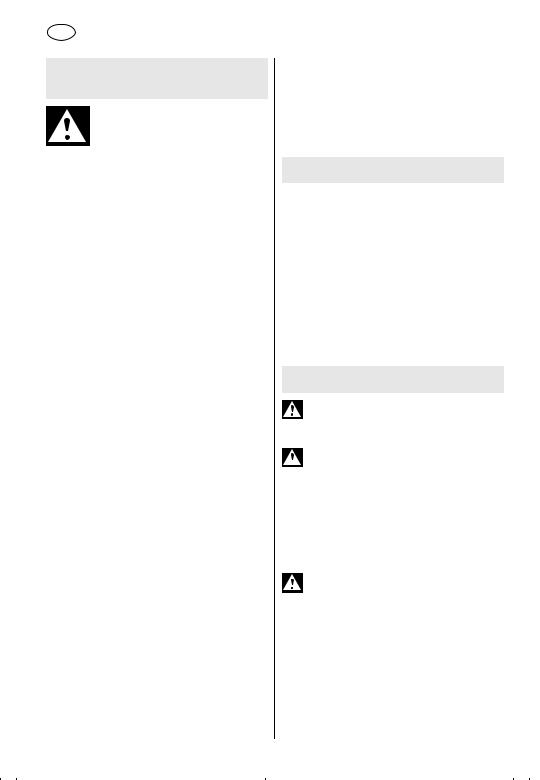
D DEUTSCH
4Spezielle Sicherheitshinweise
Beachten Sie die mit diesem Symbol gekennzeichneten Textstellen zu Ihrem eigenen Schutz und um Schutz Ihres Elektrowerkzeugs!
Tragen Sie Gehörschutz bei der Benutzung von Schlagbohrmaschinen. Die Einwirkung von Lärm kann Gehörverlust bewirken.
Benutzen Sie den mit dem Gerät gelieferten Zusatzhandgriff. Der Verlust der Kontrolle kann zu Verletzungen führen.
Halten Sie das Gerät an den isolierten Griffflächen, wenn Sie Arbeiten ausführen, bei denen das Einsatzwerkzeug verborgene Stromleitungen oder das eigene Netzkabel treffen kann.
Der Kontakt mit einer spannungsführenden Leitung kann auch metallene Geräteteile unter Spannung setzen und zu einem elektrischen Schlag führen.
Stecker aus der Steckdose ziehen, bevor irgendeine Einstellung oder Wartung vorgenommen wird.
Beachten Sie Gas-, Strom-, und Wasserleitungen!
Vermeiden Sie unbeabsichtigtes Anlaufen: stets Schalter entriegeln, wenn der Stecker aus der Steckdose gezogen wird, oder wenn eine Stromunterbrechung eingetreten ist.
Nicht an das sich drehende Werkzeug fassen!
Späne und Ähnliches nur bei Stillstand der Maschine entfernen.
Achtung beim harten Schraubfall (Einschrauben von Schrauben mit metrischem oder Zoll-Gewinde in Stahl)! Der Schraubenkopf kann abgerissen werden, bzw. es können hohe Rückdrehmomente auftreten.
Klemmt oder hakt das Einsatzwerkzeug treten hohen Kräfte auf. Die Maschine immer kräftig festhalten, einen sichereren Stand einnehmen und konzentriert arbeiten.
Kleine Werkstücke befestigen. Z. B. in einen Schraubstock einspannen.
Stäube von Materialien wie bleihaltigem Anstrich, einigen Holzarten, Mineralien und Metall können gesundheitsschädlich sein. Berühren oder Einatmen der Stäube können allergische Reaktionen und/oder Atemwegserkrankungen des Benutzers oder in der Nähe befindlicher Personen hervorrufen.
Bestimmte Stäube wie Eichenoder Buchenstaub gelten als krebserzeugend, besonders in Verbindung mit Zusatzstoffen zur Holzbehandlung (Chromat, Holzschutzmittel). Asbesthaltiges Material darf nur von Fachleuten bearbeitet
werden.
-Benutzen Sie möglichst eine Staubabsaugung.
-Sorgen Sie für gute Belüftung des Arbeitsplatzes.
-Es wird empfohlen, eine Atemschutzmaske mit
Filterklasse P2 zu tragen.
Beachten Sie in Ihrem Land gültige Vorschriften für die zu bearbeitenden Materialien.
5 Überblick
Siehe Seite 3 (bitte ausklappen).
1Bohrfutterschlüssel
(für Zahnkranz-Bohrfutter) *
2Zahnkranz-Bohrfutter *
3Schnellspann-Bohrfutter Futuro Plus *
4Bohrtiefenanschlag *
5Zusatzhandgriff *
6Drehrichtungsumschalter *
7Schaltschieber Bohren/Schlagbohren *
8Feststellknopf (Dauereinschaltung)
9Schalterdrücker
10Stellrad zur Drehzahlvorwahl *
*ausstattungsabhängig / modellabhängig
6 Inbetriebnahme
Vergleichen Sie vor Inbetriebnahme, ob die auf dem Typenschild angegebene
Netzspannung und Netzfrequenz mit den Daten Ihres Stromnetzes übereinstimmen.
SBE 561, SBE 550, SBE 521, BE 561:
 Um den sicheren Halt des Bohrfutters zu gewährleisten: Nach dem ersten Bohren (Rechtslauf) die Sicherungsschraube im Innern des Bohrfutters mit einem Schraubendreher kräftig nachziehen. Achtung Linksgewinde! (Siehe Kapitel 7.8)
Um den sicheren Halt des Bohrfutters zu gewährleisten: Nach dem ersten Bohren (Rechtslauf) die Sicherungsschraube im Innern des Bohrfutters mit einem Schraubendreher kräftig nachziehen. Achtung Linksgewinde! (Siehe Kapitel 7.8)
6.1Montage des Zusatzhandgriffs
(SBE 561, SBE 550, SBE 521, SB 561)
Aus Sicherheitsgründen stets den mitgelieferten Zusatzhandgriff verwenden.
Klemmring durch Linksdrehen des Zusatzhandgriffs (5) öffnen. Zusatzhandgriff auf Spannhals der Maschine aufschieben. Bohrtiefenanschlag (4) einschieben. Zusatzhandgriff je nach Anwendung im gewünschten Winkel kräftig festziehen.
6
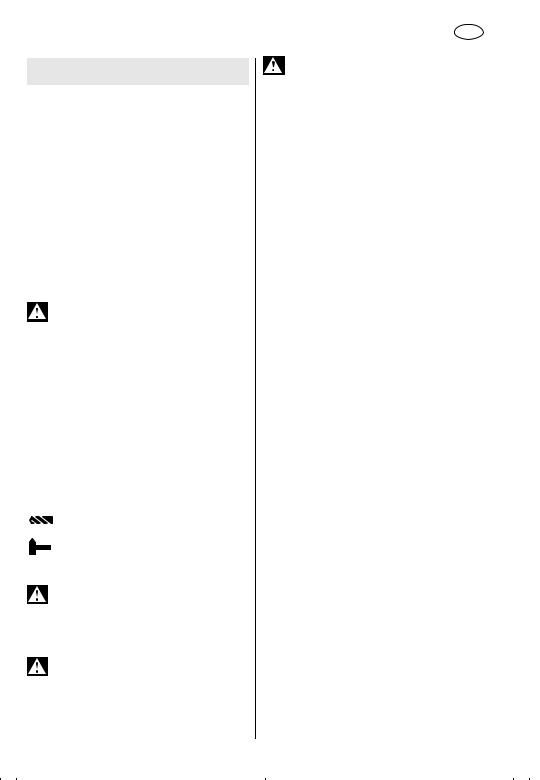
7Benutzung
7.1Verstellen des Bohrtiefenanschlags
(SBE 561, SBE 550, SBE 521, SB 561)
Zusatzhandgriff (5) lösen. Bohrtiefenanschlag (4) auf die gewünschte Bohrtiefe einstellen und Zusatzhandgriff wieder festziehen.
7.2Ein-/Ausschalten
Zum Einschalten der Maschine Schalterdrücker (9) drücken.
SBE 561, SBE 550, SBE 521, BE 561: Die Drehzahl kann am Schalterdrücker durch Eindrücken verändert werden.
Für Dauereinschaltung kann der Schalterdrücker mit dem Feststellknopf (8) arretiert werden. Zum Ausschalten Schalterdrücker erneut drücken.
Bei Dauereinschaltung läuft die Maschine weiter, wenn sie aus der Hand gerissen
wird. Daher die Maschine immer mit beiden Händen an den vorgesehenen Handgriffen festhalten, einen sicheren Stand einnehmen und konzentriert arbeiten.
7.3Drehzahl vorwählen
(SBE 561, SBE 550, SBE 521, BE 561)
Am Stellrad (10) die maximale Drehzahl vorwählen. Empfohlene Drehzahlen zum Bohren siehe Seite 4.
7.4Umschalten Bohren/Schlagbohren
(SBE 561, SBE 550, SBE 521, SB 561)
Die gewünschte Betriebsart durch Verschieben des Schaltschiebers (7) wählen.
Bohren
Schlagbohren
Im Schlagbohrbetrieb mit hoher Drehzahl arbeiten.
Schlagbohren und Bohren nur bei
Rechtslauf.
7.5Drehrichtung wählen
(SBE 561, SBE 550, SBE 521, BE 561)
Drehrichtungsumschalter (6) nur bei Stillstand des Motors betätigen.
Drehrichtung wählen:
R = Rechtslauf
L = Linkslauf
DEUTSCH D
Das Bohrfutter muss kräftig auf die Spindel aufgeschraubt und die
Sicherungsschraube im Innern des Bohrfutters mit einem Schraubendreher kräftig festgezogen sein. (Achtung Linksgewinde!) Im Linkslauf (z.B. beim Schrauben) könnte es sich sonst lösen.
7.6Werkzeugwechsel Schnellspann-Bohrfutter Futuro Plus (3)
Maschinen mit der Bezeichnung SB...:
Siehe Abbildungen, Seite 3.
Werkzeug einsetzen. Haltering (a) festhalten und mit der anderen Hand die Hülse (b) in Richtung "GRIP, ZU" drehen, bis der spürbare mechanische Widerstand überwunden ist.
Achtung! Werkzeug ist jetzt noch nicht gespannt! So lange kräftig weiterdrehen (dabei muss es "klicken"), bis kein Weiterdrehen mehr möglich ist - erst jetzt ist das Werkzeug sicher gespannt.
Bei weichem Werkzeugschaft muss eventuell nach kurzer Bohrzeit nachgespannt werden.
Bohrfutter öffnen:
Haltering (a) festhalten und mit der anderen Hand Hülse (b) in Richtung "AUF, RELEASE" drehen.
Hinweis: Das nach dem Öffnen des Bohrfutters eventuell hörbare Ratschen (funktionsbedingt) wird durch Gegendrehen der Hülse ausgeschaltet.
Bei sehr fest geschlossenem Bohrfutter:
Netzstecker ziehen. Das Bohrfutter mit einem Gabelschlüssel am Bohrfutterkopf festhalten und Hülse (b) kräftig in Richtung "AUF, RELEASE" drehen.
Maschinen mit der Bezeichnung B...:
Siehe Abbildungen, Seite 3.
Werkzeug einsetzen. Haltering (a) festhalten und mit der anderen Hand die Hülse (b) in Richtung "GRIP, ZU" drehen, bis kein Weiterdrehen mehr möglich ist.
Bei weichem Werkzeugschaft muss eventuell nach kurzer Bohrzeit nachgespannt werden.
Bohrfutter öffnen:
Haltering (a) festhalten und mit der anderen Hand Hülse (b) in Richtung "AUF, RELEASE" drehen.
Bei sehr fest geschlossenem Bohrfutter:
Netzstecker ziehen. Das Bohrfutter mit einem Gabelschlüssel am Bohrfutterkopf festhalten und Hülse (b) kräftig in Richtung "AUF, RELEASE" drehen.
7

DDEUTSCH
7.7Werkzeugwechsel Zahnkranz-Bohrfutter (2)
Siehe Abbildungen, Seite 3.
Werkzeug einspannen:
Werkzeug einsetzen und mit Bohrfutterschlüssel
(1) gleichmäßig in allen 3 Bohrungen festspannen.
Werkzeug entnehmen:
Zahnkranz-Bohrfutter (2) mit Bohrfutterschlüssel
(1) öffnen und Werkzeug entnehmen.
7.8 Bohrfutter abnehmen
Schnellspann-Bohrfutter Futuro Plus
Sicherungsschraube herausdrehen - falls vorhanden. Achtung Linksgewinde!
Bohrspindel mit einem Gabelschlüssel festhalten. Bohrfutter durch leichten Schlag mit einem Gummihammer auf einen eingespannten Sechskantschlüssel lösen und abschrauben.
Zahnkranzbohrfutter
Sicherungsschraube herausdrehen - falls vorhanden. Achtung Linksgewinde!
Bohrspindel mit einem Gabelschlüssel festhalten. Bohrfutter durch leichten Schlag mit einem Gummihammer auf den eingesteckten Bohrfutterschlüssel lösen und abschrauben.
8 Tipps und Tricks
Bei tiefen Bohrungen den Bohrer von Zeit zu Zeit aus der Bohrung ziehen, um das Bohrmehl oder Späne zu entfernen.
SBE 561, SBE 550, SBE 521, BE 561: Zum Schrauben kann das Bohrfutter abgeschraubt werden. Schrauber-Bit direkt in den Innensechskant der Spindel einsetzen.
Bei angebrachter Bit-Spannbuchse (als Zubehör: Best.-Nr. 6.31281) wird der Schrauber-Bit gehalten.
9 Wartung
Schnellspannbohrfutter reinigen:
Nach längerem Gebrauch das Bohrfutter mit der Öffnung senkrecht nach unten halten und mehrmals ganz öffnen und schließen. Der angesammelte Staub fällt aus der Öffnung. Die regelmäßige Anwendung von Reinigungsspray an den Spannbacken und Spannbackenöffnungen wird empfohlen.
f
10 Zubehör
Verwenden Sie nur original Metabo Zubehör.
Wenn Sie Zubehör benötigen, wenden Sie sich bitte an Ihren Händler.
Zur Auswahl des richtigen Zubehörs teilen Sie dem Händler bitte den genauen Typ Ihres Elektrowerkzeugs mit.
Siehe Seite 4.
AWinkelbohrund Schraubvorsatz
BBiegewelle
CBohrständer
DMaschinenschraubstock
EStahldraht-Pinselbürste
8

FStahldraht-Topfbürste
GStahldraht-Rundbürste
HBit-Spannbuchse
Zubehör-Komplettprogramm siehe www.metabo.com oder Hauptkatalog.
11 Reparatur
Reparaturen an Elektrowerkzeugen dürfen nur durch eine Elektrofachkraft ausgeführt werden!
Reparaturbedürftige Metabo Elektrowerkzeuge können an die auf der Ersatzteilliste angegebenen Adressen eingesandt werden.
Bitte beschreiben Sie bei der Einsendung zur Reparatur den festgestellten Fehler.
12 Umweltschutz
Metaboverpackungen sind 100% recyclingfähig.
Ausgediente Elektrowerkzeuge und Zubehör enthalten große Mengen wertvoller Rohund Kunststoffe, die ebenfalls einem Recyclingprozess zugeführt werden können.
Diese Gebrauchsanleitung ist auf chlorfrei gebleichtem Papier gedruckt.
Nur für EU-Länder: Werfen Sie
Elektrowerkzeuge nicht in den Hausmüll! Gemäß Europäischer Richtlinie 2002/96/EG über Elektround Elektronik-
Altgeräte und Umsetzung in nationales Recht müssen verbrauchte Elektrowerkzeuge getrennt gesammelt und einer umweltgerechten Wiederverwertung zugeführt werden.
13 Technische Daten
Erläuterungen zu den Angaben auf Seite 2.
Änderungen im Sinne des technischen Fortschritts vorbehalten.
P1 |
= |
Nennaufnahmeleistung |
P2 |
= |
Abgabeleistung |
n0 |
= |
Leerlaufdrehzahl |
n1 |
= |
Drehzahl bei Nennlast |
ø max |
= |
maximaler Bohrdurchmesser |
s max |
= |
maximale Schlagzahl |
G |
= |
Bohrspindelgewinde |
H |
= |
Bohrspindel mit Innensechskant |
m |
= |
Gewicht ohne Netzkabel |
D |
= |
Spannhalsdurchmesser |
DEUTSCH D
Schwingungsgesamtwert (Vektorsumme dreier Richtungen) ermittelt entsprechend EN 60745:
ah, ID |
= |
Schwingungsemissionswert |
ah, D |
|
(Schlagbohren in Beton) |
= |
Schwingungsemissionswert |
|
|
|
(Bohren in Metall) |
Kh,ID,Kh,D= Unsicherheit (Schwingung)
Der in diesen Anweisungen angegebene Schwingungspegel ist entsprechend einem in EN 60745 genormten Messverfahren gemessen worden und kann für den Vergleich von Elektrowerkzeugen miteinander verwendet werden. Er eignet sich auch für eine vorläufige Einschätzung der Schwingungsbelastung.
Der angegebene Schwingungspegel repräsentiert die hauptsächlichen Anwendungen des Elektrowerkzeugs. Wenn allerdings das Elektrowerkzeug für andere Anwendungen,
mit abweichenden Einsatzwerkzeugen oder ungenügender Wartung eingesetzt wird, kann der Schwingungspegel abweichen. Dies kann die Schwingungsbelastung über den gesamten Arbeitszeitraum deutlich erhöhen.
Für eine genaue Abschätzung der Schwingungsbelastung sollten auch die Zeiten berücksichtigt werden, in denen das Gerät abgeschaltet ist oder zwar läuft, aber nicht tatsächlich im Einsatz ist. Dies kann die Schwingungsbelastung über den gesamten Arbeitszeitraum deutlich reduzieren.
Legen Sie zusätzliche Sicherheitsmaßnahmen zum Schutz des Bedieners vor der Wirkung von Schwingungen fest wie zum Beispiel: Wartung von Elektrowerkzeug und Einsatzwerkzeugen, Warmhalten der Hände, Organisation der Arbeitsabläufe.
Typische A-bewertete Schallpegel: LpA = Schalldruckpegel LWA = Schallleistungspegel
KpA, KWA= Unsicherheit (Schallpegel)
Beim Arbeiten kann der Geräuschpegel 85 dB(A) überschreiten.
 Gehörschutz tragen!
Gehörschutz tragen!
Messwerte ermittelt gemäß EN 60745.
Die angegebenen technischen Daten sind toleranzbehaftet (entsprechend den jeweils gültigen Standards).
9

ENG ENGLISH
Operating Instructions
Dear Customer,
Thank you for the trust you have placed in us by buying a Metabo power tool. Each Metabo power tool is carefully tested and subject to strict quality controls by Metabo's quality assurance. Nevertheless, the service life of a power tool depends to a great extent on you. Please observe the information contained in these instructions and the enclosed documentation. The more carefully you treat your Metabo power tool, the longer it will provide dependable service.
Contents
1 Declaration of Conformity
2 Specified Conditions of Use
3 General Safety Instructions
4 Special Safety Instructions
5 Overview
6 Initial Operation
6.1 Attaching the Additional Handle
(SBE 561, SBE 550, SBE 521,
SB 561)
7 Use
7.1 Adjusting the Depth Stop (SBE 561,
SBE 550, SBE 521, SB 561)
7.2 Switching On and Off
7.3 Speed Preselection (SBE 561,
SBE 550, SBE 521, BE 561)
7.4 Switching Between Normal Drilling/
Impact Drilling (SBE 561, SBE 550,
SBE 521, SB 561)
7.5 Selecting the Direction of Rotation
(SBE 561, SBE 550, SBE 521, BE 561)
7.6 Tool Change With Futuro Plus Keyless
Chuck (3)
7.7 Tool Change With Geared Chuck (2)
7.8 Removing the Chuck
8 Tips and Tricks
9 Maintenance
10 Accessories
11 Repairs
12 Environmental Protection
13 Technical Specifications
1 Conformity Declaration
We, being solely responsible, hereby declare that this product conforms to the standards and directives specified on page 2.
2 Specified Use
SBE 561, SBE 550, SBE 521, SB 561:
The machine is suitable for non-impact drilling in metal, wood, plastic and similar materials and impact drilling in concrete, stone and similar materials.
BE 561, B 561:
The machine is suitable for non-impact drilling in metal, wood, plastic and similar materials.
SBE 561, SBE 550, SBE 521, BE 561:
The machine is suitable for thread cutting and screwdriving.
The user bears sole responsibility for damage caused by improper use.
Generally accepted accident prevention regulations and the enclosed safety information must be observed.
3 General Safety Instructions
WARNING – Reading the operating  instructions will reduce the risk
instructions will reduce the risk
of injury.
WARNING Read all safety warnings and instructions. Failure to follow all safety
warnings and instructions may result in electric shock, fire and/or serious injury.
Keep all safety instructions and information for future reference.
Before using the power tool, carefully read through and familiarise yourself with all the enclosed safety information and the Operating Instructions. Keep all enclosed documentation for future reference, and pass on your power tool only together with this documentation.
4 Special Safety Instructions
For your own protection and the protection of your power tool, observe the passages marked by this symbol!
Always wear hearing protection when using hammer drills. Exposure to noise can cause loss of hearing.
10
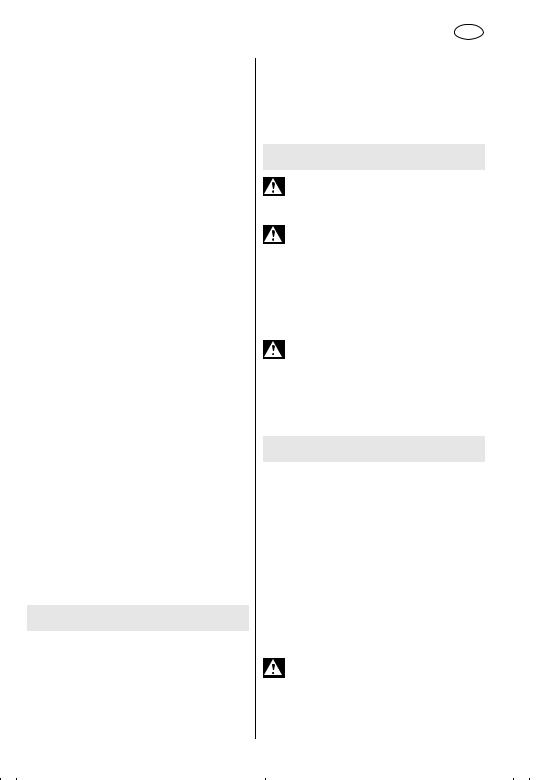
Use the additional handle supplied with the tool. Loss of control can lead to injuries.
Hold the power tool by insulated gripping surfaces when performing an operation where the cutting accessory may contact hidden wiring or its own cord. Cutting accessory contacting a "live" wire may make exposed metal parts of the power tool "live" and shock the operator.
Pull the plug out of the plug socket before any adjustments or servicing are performed.
Beware of gas/water pipes and electric cables!
Avoid inadvertent starts by always unlocking the switch when the plug is removed from the mains socket or in case of a power cut.
Keep hands away from the rotating tool!
Remove chips and similar material only with the machine at standstill.
Caution must be exercised when driving screws into hard materials (driving screws with metric or imperial threads into steel)! The screw head may break or a high reverse torque may build up.
The machine produces powerful forces when seizing or catching the workpiece. Always hold the machine firmly, adopt a steady stance and focus on your work.
Secure small workpieces. For example, clamp in a vice.
Dust from material such as paint containing lead, some wood species, minerals and metal may be harmful. Contact with or inhalation of the dust may cause allergic reactions and/or respiratory diseases to the operator or bystanders.
Certain kinds of dust are classified as carcinogenic such as oak and beech dust especially in conjunctionwithadditivesforwoodconditioning(chromate, wood preservative). Material containing asbestos must only be treated by specialists.
-Where the use of a dust extraction device is possible it shall be used.
-The work place must be well ventilated.
-The use of a dust mask of filter class P2 is
recommended.
Follow national requirements for the materials you want to work with.
5 Overview
See page 3 (please unfold).
1Chuck key (for geared chuck) *
2Geared chuck *
3Futuro Plus keyless chuck *
4Depth stop *
5Additional handle *
6Direction switch *
ENGLISH ENG
7Sliding switch for normal drilling/impact drilling *
8Lock button (continuous operation)
9Trigger
10Speed preselection wheel *
*depending on the features / model
6 Commissioning
Before plugging in, check to see that the rated mains voltage and mains frequency,
as stated on the rating label, match with your power supply.
SBE 561, SBE 550, SBE 521, BE 561:
Make sure the chuck clamps securely:
After drilling for the first time (clockwise), firmly tighten the safety screw inside the chuck using a screwdriver. Caution: left-handed thread!
(see Section 7.8)
6.1Attaching the Additional Handle
(SBE 561, SBE 550, SBE 521, SB 561)
For safety reasons, always use the additional handle supplied.
Open the clamping ring by turning the additional handle (5) anticlockwise. Push the additional handle onto the collar of the machine. Insert the depth stop (4). Securely tighten the additional handle at the angle required for the application.
7Use
7.1Adjusting the Depth Stop
(SBE 561, SBE 550, SBE 521, SB 561)
Loosen the additional handle (5). Set depth stop (4) to the desired drilling depth and retighten additional handle.
7.2Switching On and Off
To start the machine, press the trigger switch (9).
SBE 561, SBE 550, SBE 521, BE 561: Press in the trigger switch to change the speed.
For continuous operation the trigger switch can be locked using the lock button (8). To stop the machine, press the trigger switch again.
In continuous operation, the machine continues running if it is forced out of your
hands. Therefore, always hold the machine with both hands using the handles provided, stand in a safe position and concentrate.
11
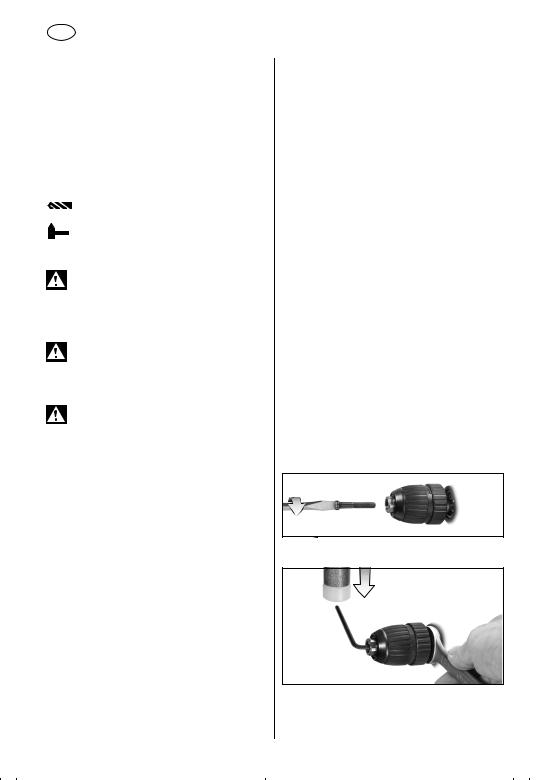
ENG ENGLISH
7.3Speed Preselection
(SBE 561, SBE 550, SBE 521, BE 561)
Select the (10) maximum speed using the preselection wheel. See page 4 for recommended drilling speeds.
7.4Switching Between Normal Drilling/ Impact Drilling
(SBE 561, SBE 550, SBE 521, SB 561)
Select the desired operating mode by pushing the sliding switch (7).
Drilling
Impact drilling
Work with high speed settings when impact drilling.
Impact drilling and normal drilling only in a clockwise direction.
7.5Selecting the Direction of Rotation
(SBE 561, SBE 550, SBE 521, BE 561)
Do not activate the direction switch (6) unless the motor has completely stopped.
Select direction of rotation: R = Clockwise
L = Anticlockwise
Screw the chuck firmly to the spindle and tighten the safety screw inside the chuck
using a screwdriver. (Caution: left-handed thread!)
Otherwise it may come loose during anticlockwise operation (e.g. when screwdriving).
7.6Tool Change With
Futuro Plus Keyless Chuck (3)
Machines with the designation SB...:
See illustrations on page 3.
Insert the tool. Hold the retaining ring (a) firmly and turn the collet (b) towards "GRIP, ZU" with the other hand until the mechanical resistance which can be felt is overcome.
Caution! The tool is not yet clamped! Keep turning the sleeve (it must "click" when turning) until it cannot be turned any further - only now is the tool securely clamped.
With a soft tool shank, retightening may be required after a short drilling period.
Open the chuck:
Hold the retaining ring (a) firmly and turn the collet
(b) towards "AUF, RELEASE" with the other hand.
Note: The grating sound which may be heard after opening the drill chuck is functional and is stopped by turning the sleeve in the opposite direction.
If the chuck is very securely tightened: Unplug. Hold the drill chuck using an open-end spanner at the flats on its head, and turn the sleeve (b) vigourously in the direction of "AUF, RELEASE".
Machines with the designation B...:
See illustrations on page 3.
Insert the tool. Hold the retaining ring (a) firmly and turn the collet (b) towards "GRIP, ZU" with the other hand until it will not turn any further.
With a soft tool shank, retightening may be required after a short drilling period.
Open the chuck:
Hold the retaining ring (a) firmly and turn the collet
(b) towards "AUF, RELEASE" with the other hand.
If the chuck is very securely tightened: Unplug. Hold the drill chuck using an open-end spanner at the flats on its head, and turn the sleeve (b) vigourously in the direction of "AUF, RELEASE".
7.7Tool Change With Geared Chuck (2)
See illustrations on page 3.
Clamping tools:
Insert the tool and clamp evenly in all 3 holes using the chuck key (1).
Removing tools:
Open the geared chuck (2) using the chuck key (1) and remove the tool.
7.8 Removing the Chuck
Futuro Plus keyless chuck
Unscrew the safety screw - if available. Caution: left-handed thread!
Hold the drill spindle securely using an open-end wrench. Clamp an Allen key in the chuck and strike lightly with a rubber hammer to loosen, then unscrew.
12
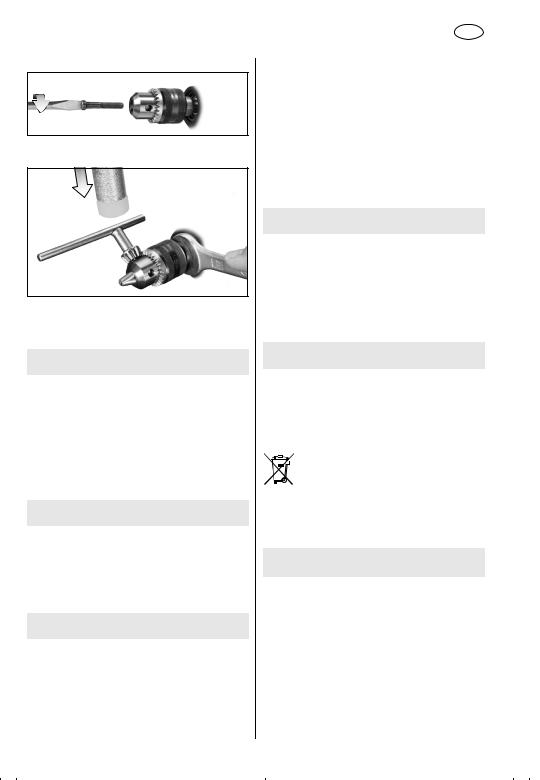
Geared chuck
Unscrew the safety screw - if available. Caution: left-handed thread!
Hold the drill spindle securely using an open-end wrench. Insert the key in the chuck and strike lightly with a rubber hammer to loosen, then unscrew.
8 Tips and Tricks
In the case of deep bores, pull the drill bit out of the bore from time to time in order to remove the drill dust or swarf.
SBE 561, SBE 550, SBE 521, BE 561: The chuck can be removed to insert a screwdriver bit. Insert the bit directly in the hexagon socket on the spindle.
The screwdriver bit is retained if a bit clamping bush (as an accessory: order no. 6.31281) is fitted.
9 Maintenance
Keyless chuck cleaning:
After prolonged use hold the chuck vertically, with the opening facing down, and fully open and close it several times. The dust collected falls from the opening. Regular use of cleaning spray on the jaws and jaw openings is recommended.
f
10 Accessories
Use only genuine Metabo accessories.
If you need any accessories, check with your dealer.
For dealers to select the correct accessory, they need to know the exact model designation of your power tool.
ENGLISH ENG
See page 4.
AAngle attachment
BFlexible drive shaft
CDrill stand
DMachine vice
ESteel wire end brush
FSteel wire cup brush
GSteel wire wheel
HBit clamping bush
For complete range of accessories, see www.metabo.com or the main catalogue.
11 Repairs
Repairs to electrical tools must be carried out by qualified electricians ONLY!
Any Metabo power tool in need of repair can be sent to one of the addresses listed in the spare parts list.
Please enclose a description of the fault with the power tool.
12 Environmental Protection
Metabo's packaging can be 100% recycled.
Scrap power tools and accessories contain large amounts of valuable resources and plastics that can be recycled.
These instructions are printed on chlorine-free bleached paper.
Only for EU countries: Never dispose of
power tools in your household waste! In accordance with European Guideline 2002/96/EC on used electronic and
electric equipment and its implementation in national legal systems, used power tools must be collected separately and handed in for environmentally compatible recycling.
13 Technical Specifications
Explanatory notes on the specifications on page 2.
Changes due to technological progress reserved.
P1 |
= |
Nominal power input |
P2 |
= |
Power output |
n0 |
= |
No load speed |
n1 |
= Speed at rated load |
|
ø max |
= Max. solid drill diameter |
|
s max |
= |
Max. impact rate |
G= Drill spindle thread
H= Drill spindle with hexagon socket
m |
= |
Weight without mains cable |
D |
= |
Collar diameter |
13

ENG ENGLISH
Vibration total value (vector sum of three directions) determined in accordance with EN 60745:
ah, ID |
= |
Vibration emission value |
ah, D |
|
(impact drilling into concrete) |
= |
Vibration emission value |
|
Kh,ID,Kh,D= |
(drilling into metal) |
|
Unsafe (vibration) |
||
The vibration emission level given in this information sheet has been measured in accordance with a standardised test given in EN 60745 and may be used to compare one tool with another. It may be used for a preliminary assessment of exposure.
The declared vibration emission level represents the main applications of the tool. However if the tool is used for different applications, with different accessories or poorly maintained, the vibration emission may differ. This may significantly increase the exposure level over the total working period.
An estimation of the level of exposure to vibration should also take into account the times when the tool is switched off or when it is running but not actually doing the job. This may significantly reduce the exposure level over the total working period.
Identify additional safety measures to protect the operator from the effects of vibration such as: maintain the tool and the accessories, keep the hands warm, organisation of work patterns.
Typical A-effective perceived sound levels:
LpA |
= |
Sound pressure level |
LWA |
= |
Acoustic power level |
KpA, KWA = Unsafe (noise level)
During operation the noise level can exceed 85 dB(A).
 Wear ear protectors!
Wear ear protectors!
Measured values determined in conformity with EN 60745.
The technical specifications quoted are subject to tolerances (in compliance with the relevant valid standards).
14

FRANÇAIS F
Mode d'emploi
Cher client,
merci de la confiance que vous nous avez témoignée en achetant un outil électrique Metabo. Tous les outils électriques Metabo sont testés avec soin et font l'objet de contrôles qualité très stricts effectués par le Service Qualité Metabo. Mais c'est vous qui avez la plus grande influence sur la durée de vie de votre outil électrique. Veuillez respecter les informations contenues dans ces instructions d'utilisation et dans les documents ci-joints. En prenant grand soin de votre outil électrique Metabo, vous en augmenterez la durée de vie et en garantirez le bon fonctionnement.
Sommaire
1 Déclaration de conformité
2 Utilisation conforme à la destination
3 Consignes générales de sécurité
4 Consignes de sécurité particulières
5 Vue d'ensemble
6 Mise en service
6.1 Montage de la poignée supplémentaire (SBE 561, SBE 550, SBE 521,
SB 561) 7 Utilisation
7.1 Réglage de la butée de profondeur de perçage (SBE 561, SBE 550,
SBE 521, SB 561) 7.2 Marche/arrêt
7.3 Présélection de la vitesse (SBE 561, SBE 550, SBE 521, BE 561)
7.4 Sélection perçage avec/sans percussion (SBE 561, SBE 550, SBE 521, SB 561)
7.5 Sélection du sens de rotation
(SBE 561, SBE 550, SBE 521, BE 561) 7.6 Changement d'accessoire avec le
mandrin autoserrant Futuro Plus (3) 7.7 Changement d'accessoire avec le
mandrin à clé (2) 7.8 Dépose du mandrin
8 Conseils et astuces
9 Maintenance
10 Accessoires
11 Réparations
12 Protection de l'environnement
13 Caractéristiques techniques
1 Déclaration de conformité
Nous déclarons sous notre propre responsabilité que ce produit est conforme aux normes et directives indiquées page 2.
2Utilisation conforme à la destination
SBE 561, SBE 550, SBE 521, SB 561 :
Cette machine convient pour le perçage sans percussion sur métal, bois, matières plastiques et assimilées, ainsi que pour le perçage avec percussion sur béton, pierre et matériaux similaires.
BE 561, B 561 :
Cette machine convient pour le perçage sans percussion sur métal, bois, matières plastiques et assimilées.
SBE 561, SBE 550, SBE 521, BE 561 :
Cette machine convient pour les travaux de taraudage et de vissage.
L'utilisateur sera entièrement responsable de tous dommages résultant d'une utilisation non conforme à la destination de la machine.
Il est impératif de respecter les consignes générales de protection contre les accidents ainsi que les consignes de sécurité ci-jointes.
3Consignes générales de sécurité
AVERTISSEMENT – Lire la notice  d'utilisation afin d'éviter tout risque de blessure.
d'utilisation afin d'éviter tout risque de blessure.
AVERTISSEMENT Lire toutes les consignes de sécurité et instructions.
Le non-respect des consignes de sécurité et des instructions peut être à l'origine d'un choc électrique, d'un incendie et/ou de blessures graves.
Conserver toutes les consignes de sécurité et instructions.
Avant d'utiliser l'outil électrique, lire attentivement et entièrement les instructions de sécurité ainsi que le mode d'emploi ci-joints. Conserver les documents ci-joints et veiller à les remettre obligatoirement avec l'appareil à tout utilisateur concerné.
15
